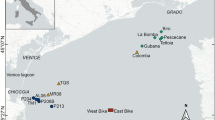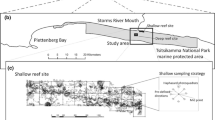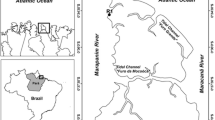Abstract
Previous studies from other latitudes have demonstrated that depth and spatial heterogeneity, produced by surface inclination, can have strong effects on diversity and distribution of sessile assemblages on rocky reefs. Rocky reef communities in the subantarctic Magellan region have been rarely studied, and the factors influencing diversity, distribution and abundance of benthic communities remain poorly understood. Sessile benthic assemblages inhabiting rocky reefs habitats were studied by SCUBA diving at Punta Santa Ana, Magellan Strait from 0 to 30 m water depth. We describe the sessile assemblages assessing the effect of depth, inclination and other environmental factors on species richness and community structure. A total of 37 taxa of invertebrates and 31 taxa of macroalgae were identified based on 280 high-resolution photoquadrats. Species richness and percent coverage varied with depth and inclination. Macroalgae dominated in abundance in the shallows, while bryozoans and ascidians (mound and tree-like forms) increased their coverage with depth. Lithothamnion sp. dominated on vertical and inclined surfaces while sheet-like organism such as bryozoans increased their coverage on overhanging surfaces. Multivariate analyses showed that sessile assemblages at Punta Santa Ana are strongly influenced by the interaction between inclination and depth, which alter the effect of other physical factors such as light and sedimentation. In this regard, our results suggest that sedimentation may play a role structuring benthic assemblages in Punta Santa Ana, especially in deeper zones, where it may replace the structuring effect produced by light in the shallows.





Similar content being viewed by others
References
Airoldi L, Cinelli F (1997) Effects of sedimentation on subtidal macroalgal assemblages: an experimental study from a mediterranean rocky shore. J Exp Mar Biol Ecol 215:269–288
Alveal K, Romo H, Valenzuela J (1973) Consideraciones ecológicas de las regiones de Valparaíso y Magallanes. Rev Biol Mar 15:1–29
Anderson MJ (2001) A new method for non-parametric multivariate analysis of variance. Austral Ecol 26:32–46
Anderson MJ, Gorley RN, Clarke KR (2008) Permanova for primer: guide to software and statistical methods. PRIMER-E, Plymouth
Antezana T (1999) Hydrographic features of Magellan and Fuegian inland passages and adjacent Subantarctic waters. Sci Mar 69:23–34
Barnes DKA (1995a) Sublittoral epifaunal communities at Signy Island, Antarctica. I. The ice foot zone. Mar Biol 121:555–563
Barnes DKA (1995b) Sublittoral epifaunal communities at Signy Island, Antarctica. II. Below the ice foot zone. Mar Biol 121:565–572
Barnes DKA (1999) The influence of ice on polar nearshore benthos. J Mar Biol Assoc UK 79:401–407
Barnes DKA (2005) Changing chain: past, present and future of the Scotia Arc’s and Antarctica’s shallow benthic communities. Sci Mar 69:65–89
Barnes DKA, Brockington S (2003) Zoobenthic biodiversity, biomass and abundance at Adelaide Island, Antarctica. Mar Ecol Prog Ser 249:145–155
Baynes TW (1999) Factors structuring a subtidal encrusting community in the southern Gulf of California. Bull Mar Sci 64:419–450
Bell JJ (2001) The influence of water flow rate, depth and surface inclination on the density and the distribution of five species of temperate anthozoa at Lough Hyne, Ireland. J Mar Biol Assoc UK 81:883–884
Bell JJ, Barnes DKA (2000a) The distribution and prevalence of sponges in relation to environmental gradients within a temperate sea lough: inclined cliff surfaces. Divers Distrib 6:305–323
Bell JJ, Barnes DKA (2000b) The distribution and prevalence of sponges in relation to environmental gradients within a temperate sea lough: vertical cliff surfaces. Divers Distrib 6:282–303
Bell JJ, Barnes DKA (2000c) A sponge diversity centre within a marine ‘island’. Hydrobiologia 440:55–64
Benedetti-Cecchi L (2001) Variability in abundance of algae and invertebrates at different spatial scales on rocky sea shores. Mar Ecol Prog Ser 215:79–92
Beuchel F, Gulliksen B, Carroll ML (2006) Long term patterns (1980–2003) of rocky-bottom macrobenthic community structure in an Arctic fjord (Kongsfjorden, Svalbard) in relation to climate variability. J Mar Syst 63:35–48
Boaventura D, Moura A, Leitao F, Carvalho S, Curdia J, Pereira P, de Fonseca LC, dos Santos MN, Monteiro CC (2006) Macrobenthic colonisation of artificial reefs on the southern coast of Portugal (Ancao, Algarve). Hydrobiologia 555:335–343
Bowden DA (2005) Quantitative characterization of shallow marine benthic assemblages at Ryder Bay, Adelaide Island, Antarctica. Mar Biol 146:1432–1793
Cárdenas CA (2008) Factores que organizan la estructura comunitaria del megaepibentos del submareal rocoso de Punta Santa Ana, Estrecho de Magallanes, Chile. Tesis para optar al grado de Magíster en Ciencias con mención en Manejo y Conservación de Recursos Naturales de Ambientes Subantárticos. Facultad de Ciencias, Departamento de Ciencias y Recursos Naturales, Punta Arenas, Chile
Cárdenas CA, Davy SK, Bell JJ (2012) Correlations between algal abundance, environmental variables and sponge distribution patterns on southern hemisphere temperate rocky reefs. Aquat Biol 16:229–239
Carney D, Oliver JS, Armstrong C (1999) Sedimentation and composition of wall communities in Alaskan fjords. Polar Biol 22:38–49
Chao A (1987) Estimating the population size for capture-recapture data with unequal catchability. Biometrics 43:783–791
Chao A, Chazdon RL, Colwell RK, Shen T-J (2005) A new statistical approach for assessing similarity of species composition with incidence and abundance data. Ecol Lett 8:148–159
Clarke KR, Gorley RN (2006) Primer v6: user manual/tutorial
Colwell RK (2009) EstimateS: statistical estimation of species richness and shared species from samples. Version 8.2. User’s Guide and application published at: http://purl.oclc.org/estimates
Dayton PK (1985) The structure and regulation of some South American kelp communities. Ecol Monogr 55:447–468
Eckman JE, Duggins DO (1991) Life and death beneath macrophyte canopies: effects of understory kelps on growth rates and survival of marine, benthic suspension feeders. Oecologia 87:473–487
Ferdeghini F, Acunto S, Cocito S, Cinelli F (2000) Variability at different spatial scales of a coralligenous assemblage at Giannutri Island (Tuscan Archipelago, northwest Mediterranean). Hydrobiologia 440:27–36
Försterra G, Beuck L, Häussermann V, Freiwald A (2005) Shallow water Desmophyllum dianthus (Scleractinia) from Chile: characteristics of the biocenoses, the bioeroding community, heterotrophic interactions and (palaeo)-bathymetrical implications. In: Freiwald A, Roberts JM (eds) Cold-water corals and ecosystems. Springer, Berlin, Heidelberg, pp 937–977
Freeman D, Cooper S, Funnell G, Neale D (2011) Nearshore benthic community structure at the Bounty and Antipodes Islands, Subantarctic New Zealand. Polar Biol 34:1485–1499
Glasby TM, Connell SD (2001) Orientation and position of substrata have large effects on epibiotic assemblages. Mar Ecol Prog Ser 214:127–135
Gotelli NJ (1988) Determinants of recruitment, juvenile growth, and spatial distribution of a shallow-water gorgonian. Ecology 69:157–166
Grange KR, Singleton RJ, Richardson JR, Hill PJ, Main WdL (1981) Shallow rock-wall biological associations of some southern fjords of New Zealand. N Z J Zool 8:209–227
Gulliksen B (1978) Rocky bottom fauna in a submarine gulley at Loppkalven, Finnmark, Northern Norway. Est Coast Mar Sci 7:361–372
Gutt J, Helsen E, Arntz W, Buschmann A (1999) Biodiversity and community structure of the mega-epibenthos in the Magellan region (South America). Sci Mar 63:155–170
Häussermann V, Försterra G (2007) Extraordinary abundance of hydrocorals (Cnidaria, Hydrozoa, Stylasteridae) in shallow water of the Patagonian fjord region. Polar Biol 30:487–492
Hiscock K (1985) Aspects of the ecology of rocky subtidal areas. In: Moore PG, Seed R (eds) The ecology of rocky coasts. Hodder and Stoughton Educational, Kent, pp 290–328
Irving AD, Connell SD (2002) Sedimentation and light penetration interact to maintain heterogeneity of subtidal habitats: algal versus invertebrate dominated assemblages. Mar Ecol Prog Ser 245:83–91
Jackson JBC (1979) Morphological strategies in sessile animals. In: Jackson JBC, Buss LW, Cook RE (eds) Population biology and evolution of clonal organisms. University Press, New Haven, pp 499–555
Jørgensen LL, Gulliksen B (2001) Rocky bottom fauna in arctic Kongsfjord (Svalbard) studied by means of suction sampling and photography. Polar Biol 24:113–121
Kohler KE, Gill SM (2006) Coral point count with excel extensions (CPCe): a visual basic program for the determination of coral and substrate coverage using random point count methodology. Comput Geosci 32:1259–1269
Konar B, Iken K, Edwards M (2009) Depth-stratified community zonation patterns on Gulf of Alaska rocky shores. Mar Ecol 30:63–73
Laudien J, Orchard J-B (2012) The significance of depth and substratum incline for the structure of a hard bottom sublittoral community in glacial Kongsfjorden (Svalbard, Arctic)—an underwater imagery approach. Polar Biol 35:1057–1072
Leichter JJ, Witman JD (1997) Water flow over subtidal rock walls: relation to distributions and growth rates of sessile suspension feeders in the Gulf of Maine Water flow and growth rates. J Exp Mar Biol Ecol 209:293–307
Leps J, Smilauer P (2003) Multivariate analysis of ecological data using CANOCO. Cambridge University Press, Cambridge
Logan A, Page FH, Thomas MHL (1984) Depth zonation of epibenthos on sublittoral hard substrates off Deer Island, Bay of Fundy, Canada. Est Coast Shelf Sci 18:571–592
Maldonado M, Giraud K, Carmona C (2008) Effects of sediment on the survival of asexually produced sponge recruits. Mar Biol 154:631–641
Maughan BC (2001) The effects of sedimentation and light on recruitment and development of a temperate, subtidal, epifaunal community. J Exp Mar Biol Ecol 256:59–71
Miller RJ, Etter RJ (2008) Shading facilitates sessile invertebrate dominance in the rocky subtidal Gulf of Maine. Ecology 89:452–462
Miller RJ, Etter RJ (2011) Rock walls: small-scale diversity hotspots in the subtidal Gulf of Maine. Mar Ecol Prog Ser 425:153–165
Newcombe EM, Cárdenas CA (2011) Rocky reef benthic assemblages in the Magellan Strait and the South Shetland Islands (Antarctica). Rev Biol Mar Oceanogr 46:177–188
Newcombe EM, Cárdenas CA, Geange SW (2012) Green sea urchins structure invertebrate and macroalgal communities in the Magellan Strait, southern Chile. Aquat Biol 15:135–144
Ojeda FP, Dearborn JH (1989) Community structure of macroinvertebrates inhabiting the rocky subtidal zone in the Gulf of Maine: seasonal and bathymetric distribution. Mar Ecol Prog Ser 57:147–161
Ojeda FP, Santelices B (1984) Invertebrate communities in holdfasts of the kelp Macrocystis pyrifera from southern Chile. Mar Ecol Prog Ser 16:65–73
Panella S, Michellato A, Perdicaro R, Magazzu G, Decembrini F, Scarazzato P (1991) A preliminary contribution to understanding the hydrological characteristics of the strait of Magellan: austral spring 1989. Boll Oceanol Teor Appl 9:107–126
Pirtle JL, Ibarra SN, Eckert GL (2012) Nearshore subtidal community structure compared between inner coast and outer coast sites in Southeast Alaska. Polar Biol 35:1889–1910
Ríos C, Arntz WE, Gerdes D, Mutschke E, Montiel A (2007) Spatial and temporal variability of the benthic assemblages associated to the holdfasts of the kelp Macrocystis pyrifera in the Straits of Magellan, Chile. Polar Biol 31:89–100
Roberts DE, Davis AR, Cummins SP (2006) Experimental manipulation of shade, silt, nutrients and salinity on the temperate reef sponge Cymbastela concentrica. Mar Ecol Prog Ser 307:143–154
Sahade R, Stellfeldt A, Tatián M, Laudien J (2004) Macro-epibenthic communities and diversity of Artic Kongsfjorden, Svalbard, in relation to depth and substrate. In: C. Wiencke (ed.), The ecosystem of Kongsfjorden, Svalbard. Synopsis of biological research performed at the Koldewey station in the years 1991–2003. Ber Meeresforschung 492:103–111
Sebens KP (1985) Community ecology of vertical rock walls in the Gulf of Maine, U.S.A: small-scale processes and alternative states. In: Moore PG, Seed R (eds) The ecology of rocky coasts. Columbia University Press, New York, pp 346–371
Sebens KP (1986) Spatial relationship among encrusting marine organisms in the New England subtidal zone. Ecol Monogr 56:73–96
Simoncini M, Miller RJ (2007) Feeding preference of Strongylocentrotus droebachiensis (Echinoidea) for a dominant native ascidian, Aplidium glabrum, relative to the invasive ascidian Botrylloides violaceus. J Exp Mar Biol Ecol 342:93–98
Smale DA (2008) Continuous benthic community change along a depth gradient in Antarctic shallows: evidence of patchiness but not zonation. Polar Biol 31:189–198
Teixidó N, Garrabou J, Gutt J, Arntz WE (2004) Recovery in Antarctic benthos after iceberg disturbance: trends in benthic composition, abundance and growth forms. Mar Ecol Prog Ser 278:1–16
ter Braak CJF, Smilauer P (2002) CANOCO reference manual and CanoDraw for Windows user´s guide: software for canonical community ordination (version 4.5). Microcomputer Power, Ithaca
Valdenegro A, Silva N (2003) Caracterización oceanográfica física y química de la zona de canales y fiordos australes de Chile entre el estrecho de Magallanes y cabo de Hornos (Cimar 3 Fiordos). Cie Tecnol Mar (Valpso) 26:19–61
Vásquez JA, Castilla JC, Santelices B (1984) Distributional patterns and diets of four species of sea urchins in giant kelp forest (Macrocystis pyrifera) of Puerto Toro, Navarino Island, Chile. Mar Ecol Prog Ser 19:55–63
Wilkinson CR, Evans E (1989) Sponge distribution across davies reel great barrier reef relative to location, depth, and water movement. Coral Reefs 8:1–7
Witman JD, Cooper RA (1983) Disturbance and contrasting patterns of population structure in the brachiopod Terebratulina septentrionalis (Couthouy) from two subtidal habitats. J Exp Mar Biol Ecol 73:57–79
Witman JD, Dayton P (2000) Rocky subtidal communities. In: Bertness MD, Gaines SD, Hay ME (eds) Marine community ecology. Sinauer Associates, New York, pp 339–366
Witman JD, Etter RJ, Smith F (2004) The relationship between regional and local species diversity in marine benthic communities: a global perspective. Proc Natl Acad Sci USA 101:15665–15669
Acknowledgments
We are grateful to Mathias Hüne, Jordi Plana, Anita Ojeda and Tirzo Cárdenas for their help during fieldwork. Emma M. Newcombe and Julian Gutt provided many helpful comments on this manuscript. The authors would like to thank to the following taxonomists: Dr. Juan López-Gappa, Museo Argentino de Ciencias Naturales “Bernardino Rivadavia”, Argentina (Bryozoa); Dr. Eduardo Hajdu, Museu Nacional, Universidade Federal do Rio de Janeiro, Brasil (Porifera); Dr. Marcos Tatián, Universidad Nacional de Córdoba, Argentina and Dr. Karen Sanamyan, Kamchatka Branch of the Pacific Institute of Geography (Ascidiacea); Dr. Leen van Ofwegen-National Museum of Natural History Naturalis, Leiden, The Netherlands (Octocorallia); Dr. Nelso Navarro, Ing. Mauricio Palacios, Universidad de Magallanes, Chile and Dr. Erasmo Macaya, Universidad de Concepción, Chile (Macroalgae). Dr. Robert K. Colwell provided helpful advice regarding calculations of shared species and Jaccard estimators.
Author information
Authors and Affiliations
Corresponding author
Electronic supplementary material
Below is the link to the electronic supplementary material.
Rights and permissions
About this article
Cite this article
Cárdenas, C.A., Montiel, A. The influence of depth and substrate inclination on sessile assemblages in subantarctic rocky reefs (Magellan region). Polar Biol 38, 1631–1644 (2015). https://doi.org/10.1007/s00300-015-1729-5
Received:
Revised:
Accepted:
Published:
Issue Date:
DOI: https://doi.org/10.1007/s00300-015-1729-5




